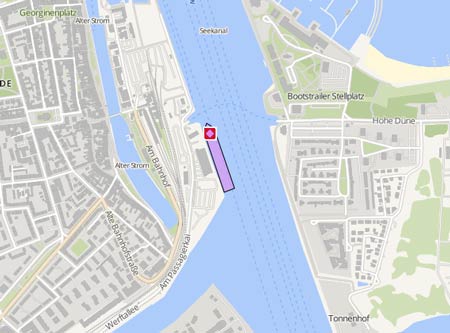OKEANOS EXPLORER
Course/Position
Latest ports
Latest Waypoints
Latest news
NOAA discovered flashy car onside the wreck of aircraft carrier USS Yorktown
On April 9, 2025, the 'Okeanos Explorer' left Pearl Harbor on a NOAA Ocean Exploration which is running 28-days charting the Papahanaumokuokea Marine National Monument, the protected archipelago that stretches westward from Kau'i to Midway Atoll. The area is home to historic WWII wrecks from the Battle of Midway in 1942, including the aircraft carrier USS 'Yorktown'. The research effort is focused on areas of interest in waters deeper than 200 meters, where ROVs are essential for access. Commissioned in 1937, the 'Yorktown' h began her first Pacific patrol just months after Pearl Harbor and saw immediate action in the Marshall Islands and the Gilberts. She played a key role in the Battle of the Coral Sea, destroying the Japanese carrier 'Shoho' and damaging the carrier 'Shikaku'. In early June 1942, the 'Yorktown' helped lead the defense of Midway, her bombers destroying carrier 'Soryu' early in the battle. The 'Yorktown' sustained multiple bomb and torpedo hits, and after taking on a heavy list, her commander ordered abandon ship. She did not sink, however, and a salvage crew initially returned to try and right her for a tow back to Pearl Harbor, but a Japanese submarine attack on June 6 damaged her further, and the list increased. The ship sank on the morning.´ of June 7. The 'Yorktown' was discovered by Robert Ballard in 1998, and the NOAA mission returned in April for a closer look at the ship - including some daring interior footage. Entering the number three elevator shaft and looking forward, the ROV crew spotted a vehicle located forward on the starboard side of the hangar deck. It had a square back, curved fenders and a now-shredded soft top. The NOAA's team surmised that the car could be Adm. Frank Fletcher's flag vehicle, since USS 'Yorktown' was his flagship. This would be consistent with a flash of chrome on the bumper and on one visible fender. Plenty of four-wheel-drive jeeps were carried aboard the 'Yorktown' and other Navy carriers in the Pacific theater, either as cargo for troops or for use as aircraft tugs - but this particular vehicle's chrome trim showed a level of flair not found on a typical GI-issue jeep. The vehicle's true identity remains to be confirmed, and the NOAA has asked for the public's help in confirming whether it may indeed have belonged to Adm. Fletcher. The NOAA believes it to be a 1940-41 Ford Super Deluxe "Woody, a civilian car with distinctive wood body and a unique combination of trim on the fenders. Report with photos: https://www.maritime-executive.com/article/noaa-finds-a-flashy-car-inside-the-wreck-of-wwii-carrier-uss-yorktown
Research ship found wreck during tests
The hull of a ship, still sheathed in copper, and the numbers "2109" on a rudder suddenly appeared in the depths of the abyss in an "unexpected and exciting discovery" that scientists from the National Oceanic and Atmospheric Administration made on May 16, 2019, while conducting a routine test of their new ROV in the Gulf of Mexico, with the "Okeanos Explorer". The wreck of what appeared to be a mid-1800s, 37.8 meters long wooden sailing vessel was picked up by sonar on the ROV Deep Discoverer. Construction features such as the form of the stern and bow, the body of the hull, and the remains of the windlass gave hints that the vessel was built in the mid-19th century. The discovery was made about 160 miles from shore, near the edge of the Florida Escarpment, in about 500 meters water depth in a steep slope on the west coast of Florida where the sea floor plunges rapidly from relatively shallow waters. While the vessel's rig, trade, nationality and crew remain a mystery, there is some evidence that the ship caught fire and was nearly completely consumed before sinking. Exactly when that might have happened, though, was still an open question. Marine life was prevalent on the wreck, except on the copper sheathing which still retained its antifouling ability to keep the hull free of marine organism. Above the water line, though, the structure was missing and there are not many traces of the standing rigging. Furthermore, a number of timbers appeared charred and some of the fasteners were bent, which may be an indication of burning," it said. "This may explain the lack of artifacts from the rigging, decks, and upper works, as well as the lack of personal possessions. Specialists stumbled upon the wreckage while conducting an engineering dive to test, calibrate, and integrate equipment and train personnel in order to ensure the collection of high-quality data throughout the remainder of 2019. They extended the ROV's dive by three hours so they could gather more information about the ship's fate. The ROV also recorded video as marine archaeologists from around the United States tuned in to assess the discovery. Experts will analyze the findings in coming months to try to learn more. Report with photos and video: https://edition.cnn.com/2019/05/30/us/shipwreck-1800-noaa-trnd/index.html
Upload News

